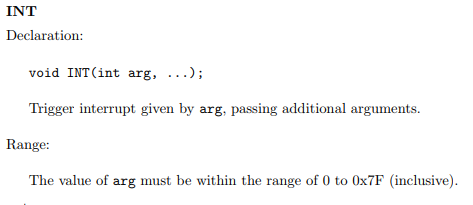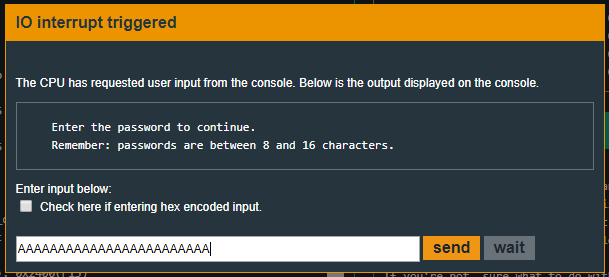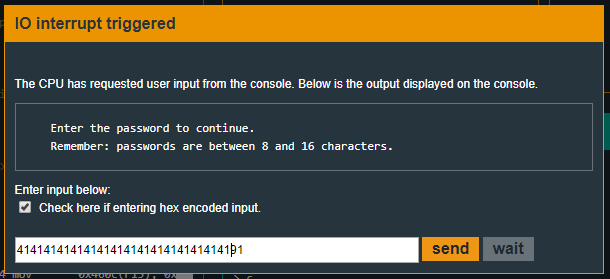In this new level some things have changed over the previous ones. If you read the manual that pops up at the beginning, you can notice that, towards the end, it states:
There is no default password on the LockIT Pro HSM-1. Upon receiving the LockIT Pro, a new password must be set by first connecting the LockitPRO HSM to output port two, connecting it to the LockIT Pro App, and entering a new password when prompted, and then restarting the LockIT Pro using the red button on the back.
That’s essentially telling us the password is checked by other device we have no access to.
If you were to execute the program, you will notice there is a message remembering the password must be between 8 and 16 characters.

So let’s explore the code and find out what’s happening! This time, main has no other task rather than calling login function.
4438 <main>
4438: b012 2045 call #0x4520 <login>
443c: 0f43 clr r15
Exploring login’s code we can make some assumptions:
4520 <login>
4520: c243 1024 mov.b #0x0, &0x2410
4524: 3f40 7e44 mov #0x447e "Enter the password to continue.", r15
4528: b012 de45 call #0x45de <puts>
452c: 3f40 9e44 mov #0x449e "Remember: passwords are between 8 and 16 characters.", r15
4530: b012 de45 call #0x45de <puts>
4534: 3e40 1c00 mov #0x1c, r14
4538: 3f40 0024 mov #0x2400, r15
453c: b012 ce45 call #0x45ce <getsn>
4540: 3f40 0024 mov #0x2400, r15
4544: b012 5444 call #0x4454 <test_password_valid>
4548: 0f93 tst r15
454a: 0324 jz $+0x8
454c: f240 2600 1024 mov.b #0x26, &0x2410
4552: 3f40 d344 mov #0x44d3 "Testing if password is valid.", r15
4556: b012 de45 call #0x45de <puts>
455a: f290 9100 1024 cmp.b #0x91, &0x2410
4560: 0720 jne #0x4570 <login+0x50>
4562: 3f40 f144 mov #0x44f1 "Access granted.", r15
4566: b012 de45 call #0x45de <puts>
456a: b012 4844 call #0x4448 <unlock_door>
456e: 3041 ret
4570: 3f40 0145 mov #0x4501 "That password is not correct.", r15
4574: b012 de45 call #0x45de <puts>
4578: 3041 ret
First of all, at address 0x453c there is a call to getsn. This time it is calling getsn instead of get_password we’ve seen in previous levels. (Even though get_password was in turn calling getsn inside, but that’s none of our concern) When using getsn one must pass two argmuments, the buffer where data must be stored and the number of bytes to be copied into it. This reminds us somehow of glibc’s fgets. (Remember we are in MSP430 context). So judging by the previous mov instructions at addresses 0x4534 and 0x4538, we can assume that our input will be stored at address 0x2400 and a maximum of 0x1c (28 decimal) bytes will be copied. This means that our input will be stored from 0x2400 all the way up to 0x241b. So the message being printed at the beginning of execution has no meaning. Passwords can be whatever length with a maximum of 28 characters.
At address 0x4544 a call to test_password_valid is made. The function’s title is pretty self explanatory. We can see that right before the call, there is a mov #0x2400, r15. That’s because it is passing as argument to test_password_valid the address the password to check is stored at.
When test_password_valid finishes, there is a tst r15 (check if it’s zero) at address 0x4548. If it is zero, it jumps to 0x4552 (using the ‘mov.b #0x26, &0x2410. This instruction is simply putting the byte 0x26 into memory address &0x2410. Please note the ‘
At address 0x455a a comparison is being made. cmp.b #0x91, &0x2410 is checking whether the value 0x91 is at memory address 0x2410. If it indeed is, it unlock the door. Otherwise it prints out “The password is not correct” and finishes the execution.
So, test_password_valid places into r15 zero. This way, we jump over instruction 0x454c which places 0x26 into memory address 0x2410. Then we must get, somehow, the value 0x91 to be into memory address 0x2410. Unlocking the level definitely depends on 0x91 being at memory address 0x2410 or not. We shall, then, explore how test_password_valid’s code looks like.
4454 <test_password_valid>
4454: 0412 push r4
4456: 0441 mov sp, r4
4458: 2453 incd r4
445a: 2183 decd sp
445c: c443 fcff mov.b #0x0, -0x4(r4)
4460: 3e40 fcff mov #0xfffc, r14
4464: 0e54 add r4, r14
4466: 0e12 push r14
4468: 0f12 push r15
446a: 3012 7d00 push #0x7d
446e: b012 7a45 call #0x457a <INT>
4472: 5f44 fcff mov.b -0x4(r4), r15
4476: 8f11 sxt r15
4478: 3152 add #0x8, sp
447a: 3441 pop r4
447c: 3041 ret
Strange. Based upon my analysis there is nothing related to placing 0x91 into 0x2410 0x446e there is a call #0x457a <INT>. That’s a call to system’s interruption function. Right above it, the previous instruction, is pushing 0x7d value into the stack. That’s because INT (interruption) function must know what interruption to execute. How can we actually know what 0x7d interruption means? Pretty simple, we must look for it in the LockIT Pro Manual that was already mentioned at the very first level, Tutorial.
At page 7 of the Manual we can see INT declaration.

From pages 8 to 10 we can see all interruptions the system can execute. In this very case, 0x7d means as follows:

So it takes two arguments. In our case r14 is the password to test and r15 is the location of the flag to overwrite is the password is correct. This definitely is related to solving the level since we already stated before that we need a zero in r15 upon exiting test_password_valid. Knowing interruptions is very important and will be later used in future levels. Another example is unlock_door function.
4448 <unlock_door>
4448: 3012 7f00 push #0x7f
444c: b012 7a45 call #0x457a <INT>
4450: 2153 incd sp
4452: 3041 ret
As you can see, 0x7f is being pushed into the stack right before INT is being called.

It takes no arguments, it simply unlocks the door.
Coming back to unlocking the level, we do not have access to the code that decides what value must be placed into r15 because it belongs to another piece of hardware.
Well then, what are we ought to do? HEY, wait a second. We just saw that unlocking the level depends upon 0x91 value being or not at 0x2410 memory address. We also saw that, despite what the program says about password being between 8 and 16 chars, we control input from 0x2400 all the way up to 0x241b which means
The only unkown that remains is whether r15 will be zero at 0x4544. Remember we want it to be zero so the 0x91 we’re about to place at 0x2410 doesn’t get overwritten by the instruction at 0x454c. Let us place a breakpoint right at 0x4548 and input some random chars and see what r15’s value is.
We place the breakpoint.

We input some random characters. (24 x A in my case)

And then we confirm r15 is indeed zero when the breakpoint is hit. That’s fantastic!

Solution
As we’ve seen before, in order to solve the level there must be a 0x91 at address 0x2410. Since our input is stored from 0x2400 to 0x241b, it is as easy as counting up bytes.
We have to input 16 random bytes, from 0x2400 to 0x240f and then 0x91. Since 0x91 is not a printable ASCII character, we will hex encode our input.
In my case my input was:

And the level is solved! :D

Recap
In this level we’ve seen how important is to understand what functions are being used and what parameters do they take as well as knwoing the memory range we’re working into and system interruptions.